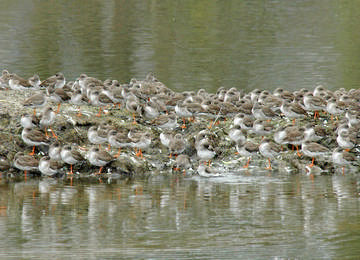
Redshank © Mike Atkinson
Cheshire and Wirral is the most important county in Britain for wintering Redshanks, with WeBS counts showing the Dee and Mersey estuaries both in the top five sites in the UK. The Dee figures include birds in Wales and inland at Inner Marsh Farm but our estuaries hold an annual average of around 10,000 birds between them. They both qualify as internationally important, exceeding the 2,800 threshold, and this is one of the species listed among their citations for European Special Protection Area and Ramsar status. Redshank is amongst the most frail of waders and is particularly susceptible to freezing conditions, so our relatively warm and sheltered west-coast estuaries may be of especial value for them (Norman & Coffey 1994).
The vast majority of these birds are of Icelandic stock, which have longer wings and shorter bills than British birds, typical adaptations for living in colder climates: work on the Mersey birds suggested that about 85% of the adult population were of the Icelandic-breeding race (Norman & Coffey 1994). Merseyside Ringing Group has records of nine birds that have been found in Iceland, including one unfortunate individual that apparently overshot and landed on a fishing boat between Iceland and Greenland, where Redshanks have never been known to breed. Some of our wintering birds are British breeders, including birds moving south from Scotland, but many British birds, especially the juvenile birds, move south to France.
Redshanks feed, singly or in small groups, on the mudflats and in the estuarine creeks, taking small molluscs and crustaceans, with the little marine shrimp corophium a favourite, and various worms. At high tides they flock to roost on the edge of the saltmarsh. As with all waders, Redshanks’ lives are dictated by the rise and fall of the tides rather than by daylight, and some birds occupy different areas at night, including some unusual sites where they would probably not feel safe by day. Edwin Samuels noted a night-time high-tide roost in a field at Bebington Oval sportscentre (SJ38H), with up to 200 birds present; in 1989 similar numbers of Redshanks roosted on the sides of a large pit within the Tranmere oil terminal complex.
The winter map shows Redshanks present at a few sites away from the estuaries, but only in small numbers. Apart from those roosting at Inner Marsh Farm, up to a maximum of 380 during this Atlas period, few Redshanks were found at any freshwater site, with 30 or more on flooded fields alongside the lower River Weaver at Aston (SJ57N) and 20 at Sandbach Flashes (SJ75J) the only double-figure counts.
From the publications of earlier Cheshire authors it is not possible to know whether there has been a change in status of wintering Redshanks. Coward (1910) wrote that ‘in December, January and February there are generally a few winter residents about the shores and marshes’, but followed that by adding that he had seen ‘very large flocks’ at the end of December on the Mersey sands near Eastham and Stanlow. Although by 1952 the famous photographer Eric Hosking knew Hilbre as the best place to film vast assemblages of waders, including Redshanks, Bell (1962 and 1967) does not even mention birds wintering on the estuaries, but over-emphasises the small numbers inland.
Sponsored by www.deeestuary.co.uk

